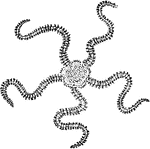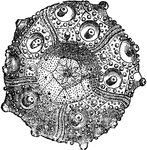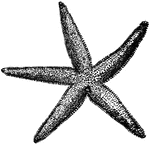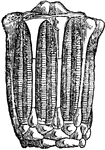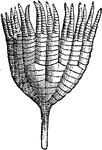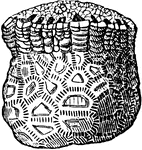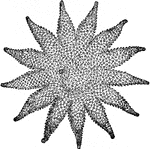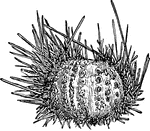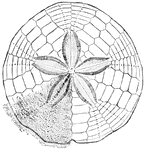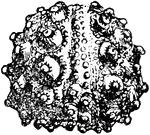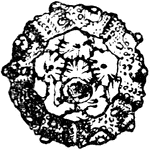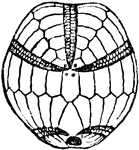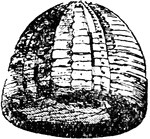The Sea Urchins and Sea Stars ClipArt gallery includes 139 illustrations of several sea star and sea urchin species. Sea stars, also called starfish, are echinoderms that are in the shape of a star, with typically five arms. Sea urchins are echinoderms that are small, spiny sea creatures shaped like a sphere or globe.
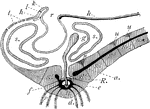
A. Rosacea Arm
"Diagrammatic vertical section through disc and base of one of the arms of Antedon rosacea. The section…
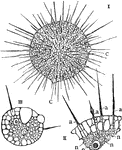
Actinosphærium
"1. The whole animal with c, c, contractile vacuoles 2. Portion of periphery more magnified with a,…

Ambulacra
"Ambulacra of Star-fish, As seen in a longitudinal and vertical section of one of the rays; and three…

Ambulacral System
"Ambulacral system of a starfish. a, ampullae; ap, Polian vesicles; c, circular canal; m, madreporite;…

Ancora
"The anchor-shaped calcareous spicules which are attached to and protrude from the flat perforated calcareous…
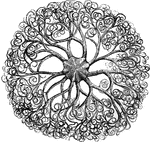
Shetland argus
"The Shetland Argus, Astrophyton scutatum, usually more than a foot across, is sometimes found on…
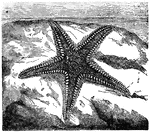
Aserias Aurantiaca (Lamarck)
"The body of the Asterias is supported by a calcareous envelop composed of juxta-imposed pieces at once…
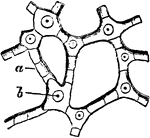
Asterius Rubens
"Tergal skeleton of Asterius rubens. a, connecting pieces; b, spinebearing plates." — Encyclopedia…
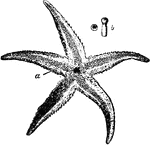
Asterius Rubens
"Asterias rubens. a, 4-ranked pedicelis; b, end of pedicel magnified." — Encyclopedia Britannica,…
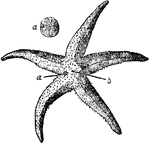
Asterius Rubens
"Antambulacral surface of Asterias rubens. a, madreporite; a', the same magnified; b, anus." —…
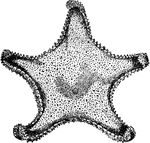
Astrogonium Phrygianum
"The rays are sometimes very short, or altogether wanting, the body having the form of a pentagonal…

Astropectenn Aurantiacus
"Section of ray of Astropecten aurantiacus. a, vertebral ossicles; b, adambulacral ossicles; c, d, marginal…
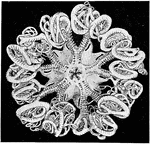
Basket Star
The giant basket star (astrophyton muricatum) is an early Mesozoic invertebrate, often found around…
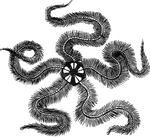
Common brittle-star
Among the several species of Brittle-Star found in the British seas is the Common Brittle-Star, Ophicoma…
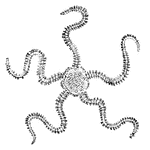
Brittlestar
The arms of the brittlestar are more flexible than those of the starfish. They move by lateral movements…

Cidaris coronata
"Cidaris coronata–a common Oolitic echinoderm…showing the spines attached to tubercles…
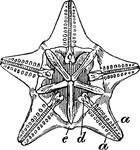
Clypeastrid
A family of irregular sea urchins, flattened into a discoidal or shield like shape, with a mouth central…
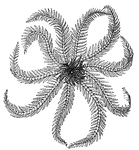
Crinoid
Crinoids are Echinoderms. They are distinguished by the fact that they are fixed, during the whole or…

Crinoid
Crinoids are Echinoderms. They are distinguished by the fact that they are fixed, during the whole or…

Crinoid
A modern crinoid showing steam with root or hold-fast attachment, and a crown composed of the calyx…
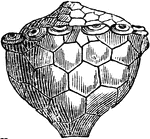
Actinocrinus
A paleozoic crinoid, Actinocrinus tricuspidatus from carboniferous limestone in Belgium.

Actinocrinus
A paleozoic crinoid, Actinocrinus triacontadactylus found in Carboniferous limestone in Lancashire.
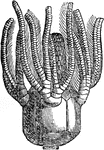
Platycrinus
A paleozoic crinoid, Platycrinus trigintidactylus from carboniferous limestone in Ireland.
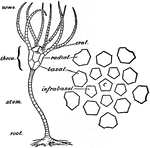
Simple Crinoid
An illustration of a simple five armed crinoid with a detailed view of the tegmen of five orals. Crinoids,…

Crinoids
Crinoids are a species of Echinoderms: "68, Apiocrinus Royssianus (a, lower part of stem); 69, portion…
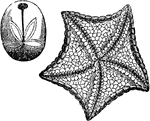
Echinodermata
"A class of radiate animals, the highest in organisation of the great division of the animal kingdom.…
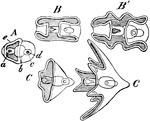
Echinopaedia
Echinopaedia is the name for the early or larval stages of echinoderms like sea stars and sea urchins.…

Echinus gracilis
"Echinus gracilis. a, ambulacral plates; b, poriferous zone; c, interambulacral plates." — Encyclopedia…
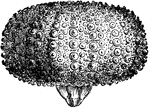
Buccal Armature of Echinus Lividus
"A species after death, when the weapons of death have been rubbed off; that is to say, the bristles.…
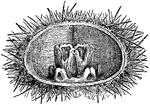
Masticating Apparatus of Echinus Lividus
The organs of mastication of the Sea Urchin. Mastication, or chewing, is the process by which food is…
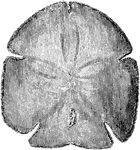
Encope
"Encope emarginata. Encope is a genus of irregular clypeastroid sea-urchins, of the family Mellitidae."…
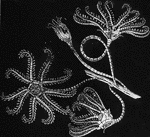
Encrindae
"Theses animals were all supported upon a long stalk, at the extremity of which they floated in the…

Encrinite
"Encrinite: head and piece of stem. Any fossil crinoid; a stone-lily: a term especially applied to the…
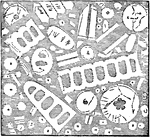
Encrinite
"Encrinite: Any fossil crinoid; a stone-lily: a term especially applied to the ordinary stalked form…
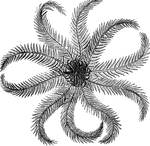
Rosy feather-star
"The body is flattened and covered with several cacareous plates; the lower, or entral surface, bears…
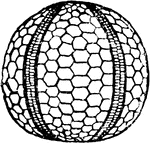
Fossil Echinidea
"Palaechinus sphaericus, Scouler; Carbouiferous, Ireland." — Encyclopedia Britannica, 1893

Fossil Echinidea
"Archaeocidaris Urii, Flem (spine and intermediate plate); Carboniferous, Ireland." — Encyclopedia…

Fossil Echinidea
"Cidaris glandifera, Goldf (spine); Jura, Mount Carmel." — Encyclopedia Britannica, 1893
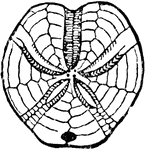
Fossil Echinidea
"Hemipneustes Greenovii, Forbes, U. Greensand, Blackdown" — Encyclopedia Britannica, 1893

Fossil Echinidea
"Cidaris florigemma, with spine, a, and single ambulacral plate, magnified, b, (after Wright; Coral…
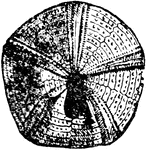
Fossil Echinidea
"Pygaster semisulcatus, Ph.; Inf. Oolite, Cheltenham." — Encyclopedia Britannica, 1893
